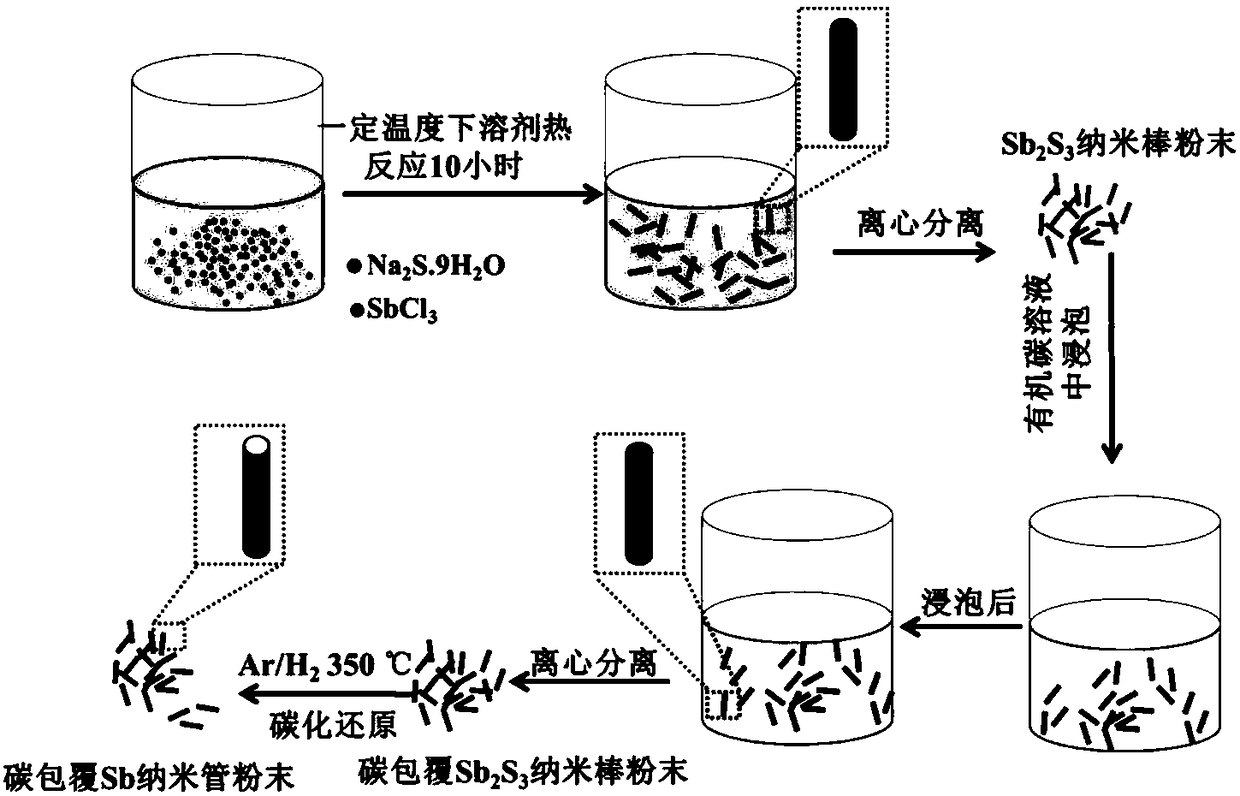Preparation method and application of carbon-coated tantalum nanotube material of negative electrode material of sodium ion battery
A technology for sodium ion batteries and negative electrode materials, which is applied in the fields of nanotechnology, battery electrodes, and nanotechnology for materials and surface science, can solve the problems of large volume change of antimony, poor electrode stability, and reduced capacity, and achieves low cost. , the preparation method is simple, the effect of high rate capacity
- Summary
- Abstract
- Description
- Claims
- Application Information
AI Technical Summary
Problems solved by technology
Method used
Image
Examples
Embodiment 1
[0034] (1) Add 3mmol Na 2 S·9H 2 O is dissolved in 20ml ethylene glycol to obtain solution A;
[0035] (2) 1mmolSbCl 3 Dissolve in 20ml ethylene glycol to obtain solution B;
[0036] (3) Add solution B dropwise to solution A and stir to obtain solution C;
[0037] (4) Transfer the solution C to a polytetrafluoroethylene-lined autoclave, and keep it at 160°C for 12 hours to obtain the synthetic product D;
[0038] (5) The synthesized product D was reacted at 120°C for 10 hours by solvent heat, centrifuged at 10,000 rpm, washed with deionized water and ethanol, and dried at 85°C for 12 hours to obtain Sb 2 S 3 powder;
[0039] (6) Sb 2 S 3 The nanorod precursor was soaked in 20 mg / ml glucose solution for 12 hours, then centrifuged and dried to obtain product E;
[0040] (7) The product E is in H 2 Annealed at 350°C for 12h in a mixed atmosphere with Ar to obtain a carbon-coated antimony nanotube anode material.
[0041] Gained carbon-coated antimony nanotube negative ...
Embodiment 2
[0044] (1) Add 3mmol Na 2 S·9H 2 O is dissolved in 20ml ethylene glycol to obtain solution A;
[0045] (2) 2mmol SbCl 3 Dissolve in 20ml ethylene glycol to obtain solution B;
[0046] (3) Add solution B dropwise to solution A and stir to obtain solution C;
[0047] (4) Transfer the C solution to a polytetrafluoroethylene-lined autoclave, and keep it at 160°C for 12 hours to obtain the synthetic product D;
[0048] (5) The synthesized product D was reacted at 120°C for 10 hours by solvent heat, centrifuged at 10,000 rpm, washed with deionized water and ethanol, and dried at 85°C for 12 hours to obtain Sb 2 S 3 powder;
[0049] (6) Sb 2 S 3 The nanorod precursor was soaked in the glucose solution of 20mg / ml concentration for 12 hours, then centrifuged and dried to obtain product E;
[0050] (7) The product E is in H 2 Annealed at 350°C for 12h in a mixed atmosphere with Ar to obtain a carbon-coated antimony nanotube anode material.
[0051] Gained carbon-coated antimo...
Embodiment 3
[0054] (1) Add 3mmol Na 2 S·9H 2 O is dissolved in 20ml ethylene glycol to obtain solution A;
[0055](2) 3mmolSbCl 3 Dissolve in 20ml ethylene glycol to obtain solution B;
[0056] (3) Add solution B dropwise to solution A and stir to obtain solution C;
[0057] (4) Transfer the C solution to a polytetrafluoroethylene-lined autoclave, and keep it at 160°C for 12 hours to obtain the synthetic product D;
[0058] (5) The synthesized product D was reacted at 200°C for 10 hours, centrifuged at 10,000 rpm, washed with deionized water and ethanol, and dried at 85°C for 12 hours to obtain Sb 2 S 3 powder;
[0059] (6) Sb 2 S 3 The nanorod precursor was soaked in the glucose solution of 20mg / ml concentration for 12 hours, then centrifuged and dried to obtain product E;
[0060] (7) The product E is in H 2 Annealed at 350°C for 12h in a mixed atmosphere with Ar to obtain a carbon-coated antimony nanotube anode material.
[0061] Gained carbon-coated antimony nanotube negati...
PUM
 Login to View More
Login to View More Abstract
Description
Claims
Application Information
 Login to View More
Login to View More - R&D
- Intellectual Property
- Life Sciences
- Materials
- Tech Scout
- Unparalleled Data Quality
- Higher Quality Content
- 60% Fewer Hallucinations
Browse by: Latest US Patents, China's latest patents, Technical Efficacy Thesaurus, Application Domain, Technology Topic, Popular Technical Reports.
© 2025 PatSnap. All rights reserved.Legal|Privacy policy|Modern Slavery Act Transparency Statement|Sitemap|About US| Contact US: help@patsnap.com

